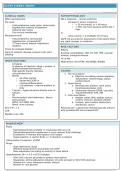Summary
Summary Renal medicine summaries
- Course
- Institution
Summary notes for renal medicine. Contains information about clinical features of each condition, as well as relevant diagnostic tests and investigations, risk factors, causes and management guidelines. Everything has been cross referenced with passmedicine or Zero to finals and management is ref...
[Show more]



